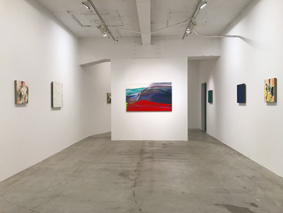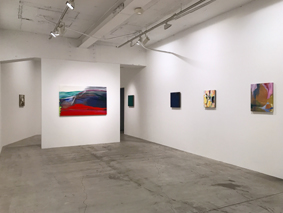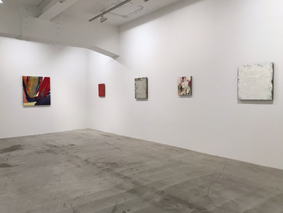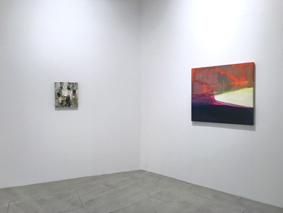| japanese I english |
About ColorManika Nagare, Michael Toenges and Peter TollensJune 10th - July 22nd, 2023taguchi fine art, Tokyo |
|





|
We are very pleased to announce the three-painters show by Manika Nagare, Michael Toenges and Peter Tollens during above period. Though they are based in different locations as in Japan and Germany, all have established careers already and are working on the subject of color, which is a fundamental element in painting. Michael Toenges Taguchi Fine Art has been showing the works by Michael Toenges through five solo shows since his first one in 2012. Born in Pfaffenhofen an der Ilm, Germany in 1952, Michael Toenges now resides in Cologne and works in Leverkusen. After graduating the School for Design and Fine Arts in Krefeld, he studied as a guest student in Fritz Schwegler class at Art Academy in Duesseldorf from 1980 until 1981. He had exhibitions in Germany, Switzerland, Belgium, Netherland and the United States. His works are in the collection of Kolumba Kunstmuseum in Cologne and Kunsthaus Aarau in Switzerland. What distinguishes the painting by Toenges is the diversity of colors and the overwhelming amount oil paint piled on the canvas/wooden board, due to that his painting looks like a relief sculpture. Toenges paints many layers of paint with brush strokes of various sizes and various colors, to create very rich surface. Because every new touch of paint is always added individually and separately, colors painted previously are not completely covered and therefore glimpse here and there. The arrangement of colors is carefully considered not only on the surface plan but also in the depth, constructed three-dimensionally. He uses so many different colors at a time but his painting always shows beautiful harmony without any failure. This must owe to the ability and the experience of the artist who has been struggling with colors for long time. Toenges habitually studies how Old Masters like Giotto, Fra Angelico, Botticelli, Goya, etc. dealt colors, through making reproductions of their works. So in his works, there appears the traditional usage of colors in the history of European painting, from medieval period, and though the Renaissance, up to the German Expressionism to which he is familiar. Peter Tollens This is the first occasion for Peter Tollens to exhibit his works in Japan. He was born in Kleve, near Duesseldorf on the Dutch border in 1954. After training as a color lithographer, he studied at the FHS for Art and Design, Cologne with Stefan Werwerka until 1981. His works are in the collections of many museums and companies, including Albright-Knox Art Gallery, Kolumba Kunstmuseum, Kunstmuseum Bonn, Kunstmuseum Duesseldorf, Museum Wiesbaden, and Staatgalerie Stuttgart, J.P.Morgan Chase &Co. etc. In 1984, Contemporary Art Association in Oberhausen held an exhibition entitled "The Presence of Color: Radical Painting". The exhibition was now regarded a historic one, dealing with two generations of post-Abstract Expressionist painters. Tollens, then 30 years old, was one of the exhibiting artists. "Radical Painting" is an idea that while following traditional painting, considers painting as an autonomous and physical object rather than as a reproduction of something external. It was popular in the 80's and most commonly associated with the American paintier Joseph Marioni, whose solo exhibition was held at Museum Wiesbaden in 2018. The Joseph Marioni exhibition also included works by Peter Tollens and by Michael Toenges, which exemplifies both two painters are highly acclaimed and positioned as current representatives of German radical painting. The distinctive characteristic of Tollens' work is that color is realized through the structure of brushstrokes. At first glance, his works appear to be monochrome paintings similar to those of Robert Ryman. But his paintings are actually composed of countless layers of carefully layered brushstrokes containing a variety of colors until the final surface layer and the brushstorokes then forms the entire picture. The viewer is driven by the desire to trace back the origin of the work to see what lies beneath. It is true that there are differences in the size, shape, density, and layering of brushstrokes, the multilayered structure of his works have much in common with the works of Michael Toenges. Manika Nagare Born in Osaka in 1975 and raised in Kagawa Prefecture, Manika Nagare graduated from the Faculty of Painting in Joshibi University of Art and Design in 1997. She stayed in New York until 2008, when she received the Japanese Agency for Cultural Affairs Grant in 2002. She also stayed in Turkey with the Pola Art Foundation Grant in 2004. She has exhibited at galleries and museums in Tokyo and many other places, and her works are in the collections of Takamatsu Art Museum, Nerima Art Museum, etc. Currently based in Tokyo, working on a number of public art projects including Azabu Library, Tokyo and Urabandai Kogen-Hotel in Fukushima as well as collaborating with fashion brands. Nagare's works, which look as if they are layered with a pale veil, are created with an original and unique technique developed by herself. She does not paint with mixing paints on a palette, but by spreading each color in a thin layer on the canvas as if tinting it, and after one layer has dried, placing another in a different color to achieve the overall color. This is an experiment by overlapping transparent color fields to achieve what the impressionist painters attempted by juxtaposing dots of color pigments. Her adaption of watercolor technique using oil paint seems to reflect her conviction of her own way of painting. Nagare is also doing researches on traditional colors, pigments, and dyes indigenous to Japan. And like Toenges, exploring the use of color by painters in the past to inform her own work. The project, entitled "Traces of Colors of Female Artists" is an attempt to reinterpret colors obtained through observation of paintings by Japanese female artists in the past, and to compose them as her own unique colors. On this occasion, several works from her latest series "In Between" will be exhibited. In between in the sense of time, In between in the sense of space, and the boundary between life and death. With these works she attempts to convey "the intense sense of life that one might feel as he or she becomes conscious of death, a glowing light, or the brilliant light and colors that may emerge at such moment (Nagare)". These three artists, who all share a strong interest in color, have been pursuing their own unique painting language. Hope the visitors will enjoy their similarities and differences among these three painters and enjoy the richness of the art of painting. checklist of the installation 1. Manika Nagare Flashbacks, 2023 oil on canvas, 90.0 x 81.0 cm 2. Peter Tollens Red (Orange Blue Green) Red, 2020 oilpaint on linen on wood, 42.0 x 38.0 cm 3. Peter Tollens Lightgrey "plowed", 2022 oilpaint on linen on wood, 55.0 x 48.5 cm 4. Michael Toenges Untitled (05-23-40-35), 2023 oil on canvas, 40.0 x 35.0 cm 5. Peter Tollens White Light ++, 2022 oilpaint on linen on wood, 60.0 x 57.0 cm 6. Manika Nagare Keeping Your Head Cool, 2023 oil on canvas, 89.4 x 145.5 cm 7. Peter Tollens MIDNIGHT -SMALL-, 2022 oilpaint on wood, 43.0 x 44.0 cm 8. Michael Toenges Untitled (02-23-40-35), 2023 oil on canvas, 40.0 x 35.0 cm 9. Manika Nagare Swirling, 2023 oil on canvas, 52.0 x 42.5 cm 10. Peter Tollens BLACK BlueGreenRedGreen, 2022 oilpaint on linen on wood, 66.0 x 62.0 cm 11. Michael Toenges Untitled (22-21-40-35), 2021 oil on canvas, 40.0 x 35.0 cm 12. Manika Nagare Nagori, 2023 oil on canvas, 81.0 x 90.0 cm 13. Peter Tollens Fast BlueGreen, 2020 oilpaint on linen on wood, 44.0 x 49.0 cm 14. Michael Toenges Untitled (01-23-40-35), 2023 oil on canvas, 40.0 x 35.0 cm 15. Manika Nagare In Between #2, 2019 oil on canvas, 60.6 x 41.0 cm 16. Manika Nagare Evergreen #2, 2021 oil on canvas, 60.6 x 41.0 cm 17. Peter Tollens Green Curtain, 2020 oilpaint on wood, 34.0 x 31.5 cm |